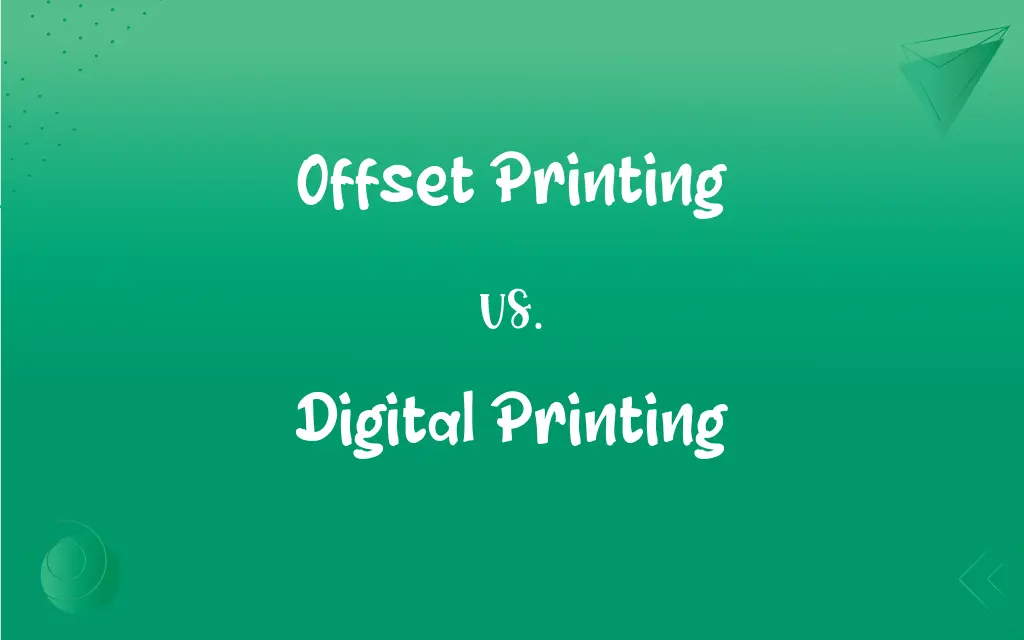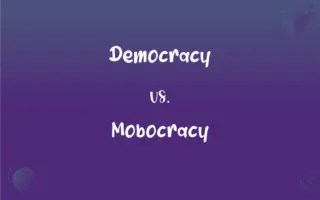Offset Printing vs. Digital Printing: What's the Difference?
Edited by Aimie Carlson || By Harlon Moss || Updated on October 26, 2023
Offset printing uses plates to transfer ink onto a medium, while digital printing employs digital files and laser or inkjet printers directly.

Key Differences
Offset printing and digital printing are two of the most popular printing methods used today, each offering distinct features and advantages. Offset printing, traditionally known for its high-quality output, involves the use of plates to transfer ink onto the print medium. This indirect method requires the ink to first be applied to a plate, which then offsets the ink to a rubber blanket, and finally, it's pressed onto the paper. In contrast, digital printing directly prints from a digital file to the printer, utilizing either laser or inkjet technology.
While both offset printing and digital printing can produce high-quality results, they cater to different needs and applications. Offset printing is particularly beneficial for large print runs, given its cost-efficiency at higher volumes. The initial setup for offset is time-consuming and expensive, but once set, the cost per page decreases with more copies printed. On the other hand, digital printing shines for short-run and personalized printing needs. Since there are no plates involved, setting up a digital print job is faster and more suited to varying designs within a single batch.
From a customization viewpoint, digital printing stands out. Digital printing allows for variable data printing, meaning each piece can be personalized. This is especially advantageous for direct mail campaigns or any project requiring unique codes, names, or addresses. Conversely, offset printing, while not as flexible for individual personalization, is unmatched in color accuracy and consistency, especially when color matching is critical.
When it comes to materials and ink, both methods again showcase their differences. Offset printing often uses a wider range of inks and can print on a more extensive variety of materials, including specialty papers, cloths, and other surfaces. Digital printing might have some material limitations due to the nature of inkjet or laser technologies.
In conclusion, while both offset printing and digital printing hold their ground in the world of print, their applications differ. Offset is often preferred for bulk, high-quality, consistent prints, while digital is the go-to for fast, short-run, and customizable projects.
ADVERTISEMENT
Comparison Chart
Printing Method
Uses plates to transfer ink.
Prints directly from a digital file.
Best for
Large volume runs.
Short runs and personalization.
Setup Time
Longer due to plate creation.
Quicker, no plates involved.
Flexibility & Customization
Limited variable data printing.
High flexibility with variable data printing.
Materials and Ink
Wide range of inks and materials.
Some limitations based on printer technology.
ADVERTISEMENT
Offset Printing and Digital Printing Definitions
Offset Printing
Offers high color accuracy and consistency.
Brands often choose offset printing when precise color matching is paramount.
Digital Printing
Uses digital files and printers without plates.
We chose digital printing for our short-run of personalized invitations.
Offset Printing
Ideal for large volume projects.
For our bulk order of brochures, we opted for offset printing to reduce costs.
Digital Printing
Allows for variable data printing.
Each certificate was uniquely printed with names using digital printing.
Offset Printing
A traditional method using plates.
The magazine was produced using offset printing for its high-quality finish.
Digital Printing
Ideal for quick, customizable projects.
With a tight deadline, digital printing was our best option for the event flyers.
Offset Printing
Requires a more extended setup time.
The lead time for the book's offset printing was a few days longer due to the plate preparation.
Digital Printing
Employs laser or inkjet technology.
The poster's vivid colors were achieved through high-quality digital printing.
Offset Printing
Involves transferring ink from plates to paper.
Offset printing remains popular due to its consistent color reproduction.
Digital Printing
Has a quicker setup process.
Thanks to digital printing, we received our business cards within a day.
FAQs
How does digital printing work?
Digital printing directly prints from a digital file using laser or inkjet printers.
Can digital printing allow for personalization within a print batch?
Yes, digital printing excels at personalization due to its variable data printing capability.
What's the main mechanism behind offset printing?
Offset printing uses plates to transfer ink to the print medium.
Why might a brand choose offset printing over digital?
Brands might choose offset for its color accuracy, consistency, and cost-effectiveness for large runs.
Which printing method is faster to set up?
Digital printing has a quicker setup process since it doesn't involve plates.
Is digital printing eco-friendly?
Digital printing can be eco-friendly, especially with reduced waste and newer ink technologies, but specifics vary by printer and ink used.
Can offset printing handle metallic or fluorescent inks?
Yes, offset printing can utilize specialty inks, including metallic and fluorescent.
How do setup costs compare between offset and digital printing?
Offset printing has higher initial setup costs due to plate creation, while digital's setup is typically lower.
How do the environmental impacts of the two methods compare?
Both have environmental considerations, from ink types to waste. Digital might have less waste due to no plates, while offset can be more efficient for larger runs. Specific impacts depend on practices and technologies used.
Is offset printing suitable for printing unique codes or names on each item?
While possible, offset printing is less suited for such tasks compared to digital printing.
Which method offers a broader range of materials for printing?
Offset printing typically allows for a more extensive range of materials compared to digital.
How does print quality compare between the two methods?
Both can offer high quality, but offset is renowned for unparalleled color accuracy and consistency.
Are there any color limitations in digital printing?
Some digital printers might have a narrower color gamut compared to offset, but advancements are continually improving color ranges.
Is there a difference in durability between the two methods?
Durability can vary based on inks, finishes, and materials used, but both methods can produce long-lasting prints.
Can you achieve textured prints with either method?
While both methods can print on textured materials, offset can utilize techniques like embossing for added texture.
Which method is more cost-effective for large volume prints?
Offset printing is typically more cost-effective for large volume prints.
Can both offset and digital printing produce high-quality outputs?
Yes, both methods can produce high-quality outputs, but the choice often depends on specific project needs.
What is the turnaround time for digital printing?
Digital printing usually has a faster turnaround time due to its direct and quick setup.
What's the main advantage of digital printing for direct mail campaigns?
Digital printing allows for personalization, making it ideal for direct mail campaigns with unique codes or addresses.
What are the material limitations of digital printing?
Digital printing may have some limitations based on the inkjet or laser technology and material compatibility.
About Author
Written by
Harlon MossHarlon is a seasoned quality moderator and accomplished content writer for Difference Wiki. An alumnus of the prestigious University of California, he earned his degree in Computer Science. Leveraging his academic background, Harlon brings a meticulous and informed perspective to his work, ensuring content accuracy and excellence.
Edited by
Aimie CarlsonAimie Carlson, holding a master's degree in English literature, is a fervent English language enthusiast. She lends her writing talents to Difference Wiki, a prominent website that specializes in comparisons, offering readers insightful analyses that both captivate and inform.































































